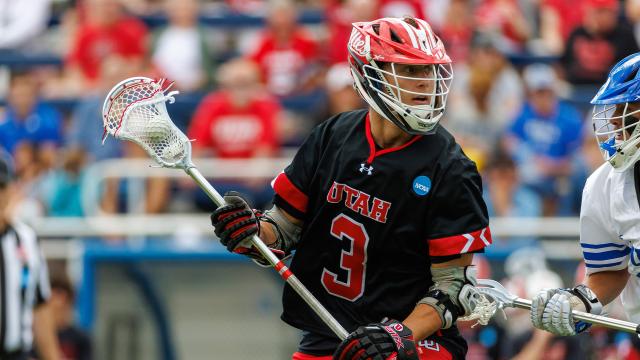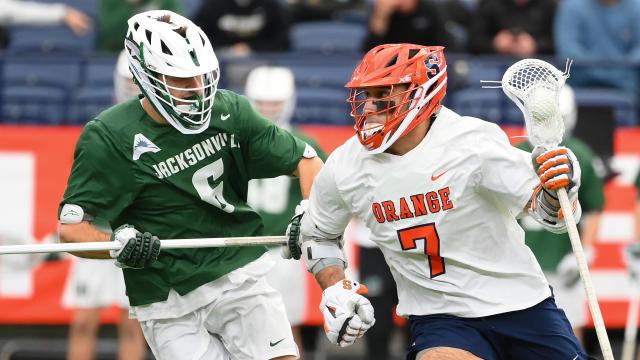
Maryland, Zappitello Smother Virginia in 12-6 NCAA Semifinal Win
PHILADELPHIA — Maryland coach John Tillman wasn’t sure what sort of ride Virginia would employ Saturday in the NCAA tournament semifinals and whether it would depend on who the Cavaliers started at goalie.
He did know the Terrapins couldn’t allow Virginia to get comfortable, which meant sticking to a tight script.
Seventh-seeded Maryland did just that, bottling up the sixth-seeded Cavaliers’ beloved transition offense and settling in for a 12-6 victory before 32,269 at Lincoln Financial Field.
It was Virginia’s lowest goal total since Feb. 13, 2016, when the Cavaliers lost 11-4 to Loyola.
“They’re a team that excels in the uneven or 5-on-5 situations and that’s what they look for,” Maryland defenseman Colin Burlace said. “A lot of it was Coach Tillman implementing a ride that got them to 6-on-6. As soon as we were able to do that, we were able to immediately find more success and stops.”
Luke Wierman won 15 of 22 faceoffs (including 10 of 12 in the first half), and Eric Spanos had two goals and three assists for the Terps (11-5), who advanced to Monday’s title game against top-seeded Notre Dame (15-1).
It is Maryland’s eighth trip to the NCAA final in 13 tournament appearances under Tillman.
McCabe Millon scored twice for the Cavaliers (12-6), while Tewaaraton finalist Connor Shellenberger was limited to a goal and an assist with Maryland defenseman Ajax Zappitello again glued to him nearly all day. Payton Cormier, Division I’s career goals leader, had a goal and an assist.
“We just couldn’t create slides today against that team defense consistently,” Virginia coach Lars Tiffany said. “Their off-ball defenders were very comfortable not sliding and making sure they could have someone on Payton Cormier all the time and they could keep the matchup of Ajax Zappitello on Connor. We were trying to change that with some off-ball motion, but when a defense doesn’t have to slide, they don’t have to worry about holding spots or playing sides. They’re like, ‘Just stay with your man.’”
That was the crux of things for Maryland, which was picked apart in a 14-10 loss to Virginia on March 16. The Cavaliers were firmly in control that day even as the Terps closed within two in the fourth quarter, playing a clean, professional game, scoring twice on the man-up and getting the better of ground ball play despite a modest deficit on faceoffs.
Virginia had none of those things going for it Saturday. It led only briefly in the opening minutes after Shellenberger blew past Zappitello for a goal that did not presage a day of dominance from the longtime May star. The Cavaliers put only 14 shots on goal, an anemic showing for a typically potent offense.
Maryland didn’t commit a penalty, and Wierman had his way in the first half, scoring his third goal in two games as the Terps built a four-goal advantage by the break before Jack Koras and Spanos quickly expanded it to 9-3 early in the third quarter.
In three NCAA tournament games, Wierman has won 55 of 77 faceoffs (71.4 percent) and has 33 ground balls.
“We were generating a lot of shots, but we just weren’t putting them on cage, and we played too much defense as it went on,” Tiffany said. “It was one of those days where we needed the ball more, and Luke Wierman wouldn’t allow that to happen.”
The Terps weren’t perfect, but Wierman and the early cushion meant they didn’t need to be.
But what they really wanted was to make Virginia work for everything, and to do so against their short-stick defensive midfielders.
“Most of the week, it’s really the unscripted lacrosse, and I thought we did a great job,” Tillman said of Maryland’s priority. “The guys followed the plan. We really tried to platoon guys and not get offensive guys caught, and they crushed us on that [in the regular season]. They crushed a lot of teams. And when they get to 5-v-5 or 4-v-4, they do such a good job.”
It didn’t happen much Saturday, with defensive midfielder Noah Chizmar’s unsettled third-quarter goal to close within 9-4 an exception.
“They take away the transition really well,” Shellenberger said. “They get their o-middies back in the hole, and even with our early offense game they still make it really tough. When you’re not able to get those couple extra goals that we’re able to get, whether it’s in transition or early offense, you have to beat them 6-v-6 like they force you to, and it makes it really tough.”
While Shellenberger was tangling with Zappitello, there wasn’t much help coming from elsewhere. Virginia’s starting midfield was held without a point on nine shots, unable to cope with the stinginess of Maryland’s defensive midfield.
The Terps, meanwhile, got goals from two first-line midfielders (Koras and Siracusa), a second-line midfielder (Jack Brennan), Wierman and Burlace, who scored his second career goal late in the first half and later tacked on his first career assist.
That came against sophomore goalie Kyle Morris (five saves), who was making his first career start after relieving Matthew Nunes early in a quarterfinal defeat of Johns Hopkins. Tiffany said Virginia settled on starting Morris after Wednesday’s practice.
But ultimately, offense was Virginia’s bulwark all season, and the Cavaliers’ scattershot day at that end (.154 shooting percentage) brought their season to an end in the semifinals for the second year in a row.
For that, Zappitello’s ability to control one of the nation’s best attackmen played a prominent role.
“We have the utmost confidence in him to win his matchup and do his job, which allows us to kind of do our own thing and not worry about that as much, being able to take a player like Connor Shellenberger and put him on an island with Ajax,” Burlace said. “Shellenberger’s going to get his now and then, but we trust Ajax, and it allows our defense to succeed and puts us in a great spot.”
In fact, it was a most enviable spot: Sixty minutes away from a national title.
Patrick Stevens
Patrick Stevens has covered college sports for 25 years. His work also appears in The Washington Post, Blue Ribbon College Basketball Yearbook and other outlets. He's provided coverage of Division I men's lacrosse to USA Lacrosse Magazine since 2010.

Related Articles





